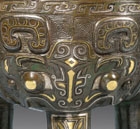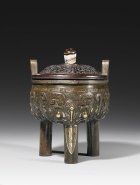J.J. Lally & Co., Oriental Art / New York City, New York
MenuPast Exhibition
Chinese Art from the Scholar’s Studio
March 13 - April 11, 2015
23.
A GOLD- AND SILVER-INLAID ARCHAISTIC
BRONZE TRIPOD CENSER
Ming Dynasty, 16th-17th Century
closely following the Shang dynasty ritual bronze liding prototype, the body divided into three rounded lobes each cast in varied relief with a taotie mask flanked by descending kui dragons and reserved on finely cast leiwen grounds, the columnar legs decorated with cicada blades, lavishly inlaid all over with gold and silver scrollwork and archaic style motifs highlighting the decoration, the rich dark reddish-brown patina giving strong contrast to the precious metal inlays, with an openwork hardwood cover with agate knop.
Height over handle 8 1⁄4 inches (21 cm)
Provenance
French Private Collection, acquired in Paris between 1950 and 1970
Compare the very similar Ming dynasty gold- and silver-inlaid bronze tripod censer in the Saint Louis Art Museum, illustrated by Hu, Later Chinese Bronzes: The Saint Louis Art Museum and Robert E. Kresko Collections, Saint Louis, 2008, pp. 56-61, no. 9. Another similar tripod censer in the collection of the Victoria & Albert Museum is illustrated by Kerr, Later Chinese Bronzes, London, 1990, p. 53, no. 41.
Compare also the Ming dynasty bronze liding of closely related form and decoration, without gold and silver inlays, in the collection of the National Palace Museum, Taipei, illustrated in the catalogue of the special exhibition, Through the Prism of the Past: Antiquarian Trends in Chinese Art of the 16th to 18th Century, Taipei, 2004, p. 96, no. II-09.
For examples of the 12th-11th century B.C. Shang bronze liding of this well known form and design, see Bagley, Shang Ritual Bronzes in the Arthur M. Sackler Collections, Cambridge, 1987, p. 486, no. 93, and pp. 487-489.
明 銅錯金銀仿古鬲鼎 高 21 厘米

